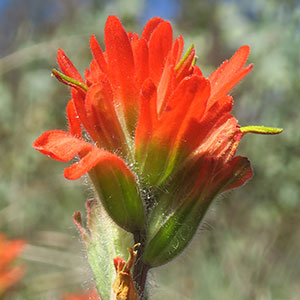Castilleja brevilobata
Castilleja tomentosa
short-lobed paintbrush
hairy Indian paintbrush, tomentose paintbrush
solitary or few, erect or ascending, unbranched, sometimes branched, hairs spreading, short, medium, and long, soft, short and medium ones short stipitate-glandular.
few to many, ascending to erect, unbranched or branched, with short, leafy axillary shoots, moderately lanate, hairs prostrate to spreading, whitish, unbranched, short, fairly soft, eglandular.
green or ± yellow, lanceolate, elliptic, or oblong to narrowly ovate, 1–2(–2.5) cm, not fleshy, margins plane or wavy, involute, (0–)3–5(–7)-lobed, apex rounded to acute;
lobes ascending to erect, linear to lanceolate, apex rounded to acute.
green, linear to narrowly lanceolate, (0.8–)3–5 cm, not fleshy, margins plane, strongly involute, 0–3(–5)-lobed, apex acute to rounded;
lobes spreading, linear, short, apex acute.
3–20 × 2–3.5 cm;
bracts proximally greenish to dull brown, distally red, orange-red, or scarlet, sometimes orange or yellow, broadly lanceolate or oblong, (0–)3–5-lobed;
lobes ascending, broadly to narrowly lanceolate, short, arising above mid length, apex acute, obtuse, or rounded.
5–20 × 0.5–2.5 cm;
bracts proximally dull brownish to deep greenish purple, distally red, red-orange, or orange, lanceolate or oblong to obovate, deeply 3(–5)-lobed;
lobes ascending, linear to lanceolate, long, arising below mid length, central lobe apex rounded to obtuse, others acute.
straight, 15–24(–26) mm;
tube 12–16 mm;
beak exserted, abaxial lip equal to calyx;
beak adaxially green or ± yellow-green, 7–10 mm, puberulent, stipitate-glandular;
abaxial lip deep green, reduced, rounded, 1–2 mm, 10–25% as long as beak;
teeth incurved to erect, light green, 0.5–1 mm.
straight or slightly curved, 12–20 mm;
tube 13–15 mm;
beak exserted or ± equal to calyx, adaxially pale green, 8–11.5 mm;
abaxial lip green or red-violet, inconspicuous, slightly pouched, 1.5–2 mm, ca. 10–20% as long as beak;
teeth incurved, pink to pale yellow or deep green, 1 mm.
green or whitish with green veins, lobes colored as bract lobes or paler, 14–30 mm;
abaxial and adaxial clefts 5.5–8.5 mm, 30–40% of calyx length, deeper than laterals, lateral 1.5–4 mm, 20–25% of calyx length;
lobes oblong to narrowly triangular, apex obtuse to rounded.
colored as bracts, (10–)13–19 mm;
abaxial and adaxial clefts 4–8(–11) mm, 33–50% of calyx length, deeper than laterals, lateral 5–7 mm, ca. 25% of calyx length;
lobes linear to lanceolate, apex acute.
= 24.
Castilleja brevilobata
Castilleja tomentosa
Castilleja brevilobata is endemic to dry serpentine openings in the Siskiyou Mountains of southwestern Oregon and adjacent California. Although sometimes treated as part of C. applegatei or C. hispida, its morphology does not suggest a close connection with either. This species occasionally hybridizes with C. pruinosa in Del Norte County, California.
(Discussion copyrighted by Flora of North America; reprinted with permission.)
In the United States, Castilleja tomentosa is known from a number of recently discovered populations in and near the southern Animas Valley, Hidalgo County, where it is found in Bouteloua gracilis and Sporobolus airoides grasslands. All known populations are small, and this species should be considered globally endangered. The only recorded Mexican station was the type locality from 1851 near Mabibi in adjacent northern Sonora. A. Eastwood (1909) believed C. tomentosa was a synonym of C. integra, but that species has mostly entire bracts, while the bracts of C. tomentosa are deeply lobed; the two also have different patterns of coloration and pubescence. T. I. Chuang annotated the holotype sheet of C. tomentosa as C. lanata, but C. tomentosa calyces have fairly deep lateral lobes, unlike the emarginate to very shallowly notched lobes of C. lanata.
(Discussion copyrighted by Flora of North America; reprinted with permission.)


